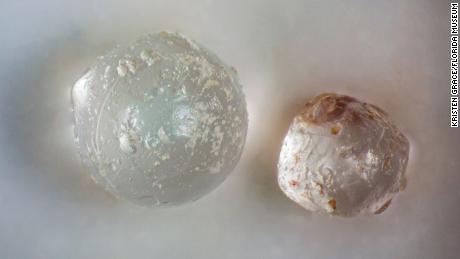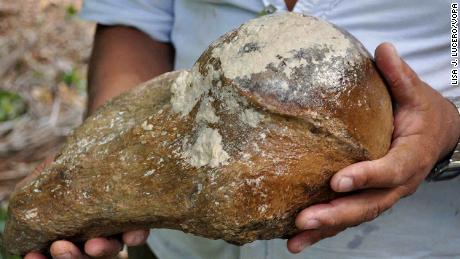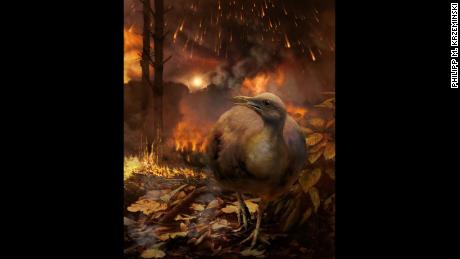(CNN)When searching for dinosaur fossils, paleontologists know that there is a certain layer in the Earth where the fossils disappear. That layer marks when an asteroid slammed into Earth 66 million years ago, causing dinosaurs to go extinct and wiping out more than 75% of species.
What happened after the mass extinction event, including how quickly plant and animal life bounced back and what those creatures were -- outside of birds -- has remained murky.
That is, until Denver Museum of Nature & Science volunteer Sharon Milito picked up an egg-shaped rock called a concretion at Corral Bluffs in Colorado. The rock contained a mammal palate inside. She brought the rock back to the museum, where paleontologist Tyler Lyson found it in a drawer.
The fossil inspired Lyson. Instead of looking for hints of bone, he wondered if he should look for concretions.
But Lyson and fellow curator and paleobotanist Ian Miller had been disappointed by a trip to Corral Bluffs before, only finding a literal handful of fossils. Scientists previously explored the outcropping of rocks in the Denver Basin 100 years before and found nothing, Miller said.
In addition to Milito's discovery of the concretion, Lyson's colleagues in South Africa searched for concretions rather than bone as well. Concretions occur when rock forms around an organic nucleus, which can be bone, Lyson said.
In 2016, Lyson and Miller returned to Corral Bluffs. They struck historical gold.
"I split open a concretion and saw a mammal skull smiling back at me," Lyson said. "And then I looked around and saw concretions just littering the landscape and was like, 'oh man, here we go.' Sure enough, we found like four or five mammal skulls within a few minutes. That was one of the most remarkable moments in my life."
The first week they were at Corral Bluffs, they "felt like anything was possible." Jaws and skulls began to stack up. The discoveries gave them goosebumps, they said.
"You could spend a whole career and not find a single skull from that time in Earth's history," Miller said. "We were finding a skull about every 15 minutes once we figured out what to look for. It happened that quickly."
Corral Bluffs is essentially a flood plain where sediment built up for a million years, preserving a time capsule of both the environment and the life that thrived there.
Over time, they discovered unusually complete fossils of mammals, reptiles and plants, according to their study that published Thursday in the journal Science. A one-hour documentary produced by NOVA about the discovery, called "Rise of the Mammals" will also be available to stream on the PBS site and will air on PBS the evening of October 30.
"We ended up collecting nearly a thousand vertebrate fossils, over 6,000 plant fossils and our colleagues counted over 37,000 pollen grains as part of this study," Lyson said. They found sixteen different kinds of mammals.
The discoveries were just the beginning. Lyson specializes in studying reptiles, but many of their finds were fossils of mammals. They also wanted to establish the layer at Corral Bluffs marking the mass extinction event. Both men reached out to experts they knew. Their colleagues were shocked to find out that such discoveries had been made at a well-known site that had previously seemed unremarkable.
"Scientists are usually really excited to be part of a project that's going to change the way we think about life on Earth, about the story of how we got to this moment," Miller said. "If you had to choose one million years in Earth's history that you really want to look at carefully, this would be it."
For the first time, the researchers were able to establish animals, plants, temperatures and a timeline of when they occurred, providing an overview of the first million years after the mass extinction event to see how the entire ecosystem recovered.
"We documented changes in the landscape after the impact, from a world dominated by palms to a world dominated by a more diverse group of trees," Miller said. "And then we saw the animal species change in lockstep fashion. And then we lined that up with changes in the environment, temperature. It turns out we really were able to paint a picture of the emergence of our modern world -- and that's phenomenal."
The pollen spores revealed the arrival of a well-known thriver in the face of a disaster: ferns. After the asteroid hit Earth, ferns popped up across the landscape because they grow well in environments that have been disturbed.
The pollen spores, in addition to layers of volcanic ash in the basin, allowed the researchers to acquire proper dating for what they found, as well as understanding the timeline of the site.
For the first thousand years after the impact, small rat-like mammals lived among ferns at the site. Around 100,000 years later, the mammal population doubled and they grew to reach the size of the average, modern raccoon. Interestingly, this is the size of the mammals living at the site just before the asteroid impact, according to the Science article published along with the study.
Palm trees replaced the ferns and 200,000 years after the impact, mammal diversity spiked again and the rat-like mammals reached the size of a beaver. They feasted on plants similar to walnuts.
And 700,000 years after the devastation, pea pods representing the arrival of legumes appear, providing protein to the growing mammal surge, both in population and size. These mammals, like the Eoconodon, could reach the size of a large dog. Forests had also recovered.
Leaves from plants revealed that the site endured three periods of warming. Just after the asteroid hit, the temperature spiked by five degrees Celsius.
Volcanic eruptions, like those preserved at the Deccan Traps in India, show that they likely helped warm up the planet.
Considering how widespread and catastrophic the damage was across Earth after the asteroid impact, 700,000 years doesn't seem that long. But the scientists also want to understand if this recovery timeline is standard or an exception.
"The exciting thing is that this is not the end of the story. This is the start of something big," Lyson said.




































